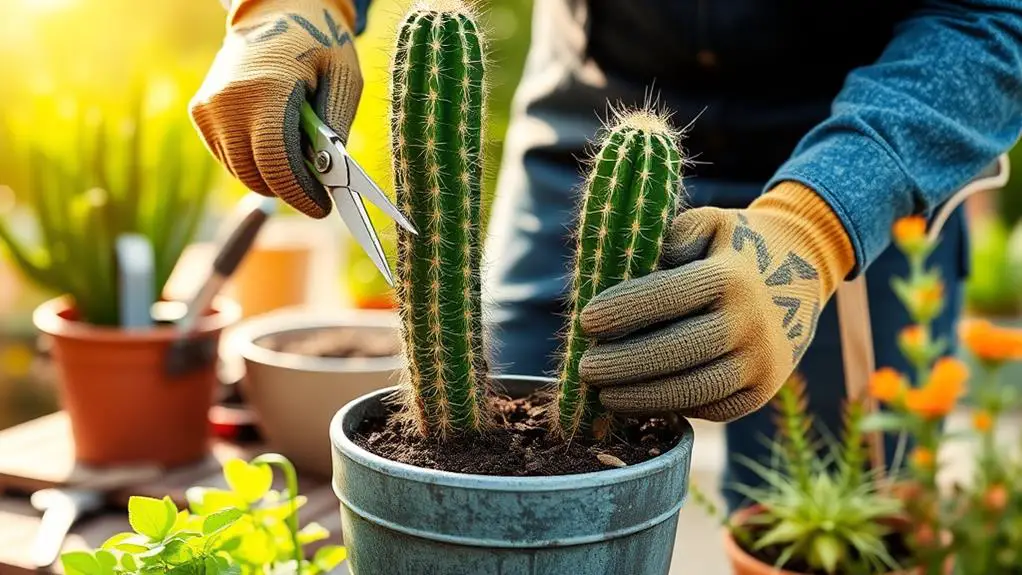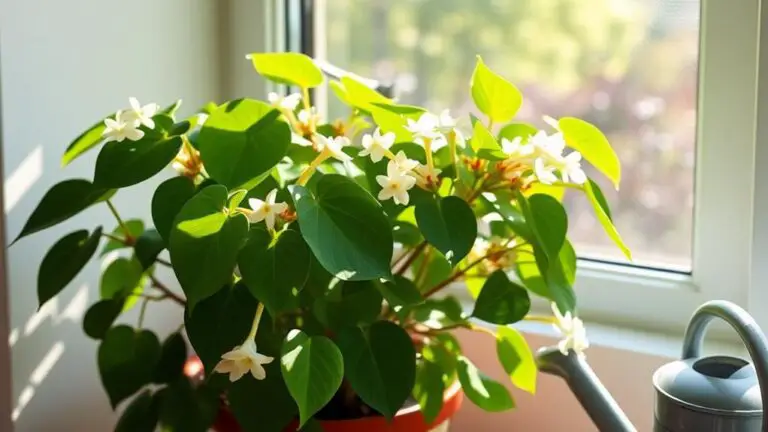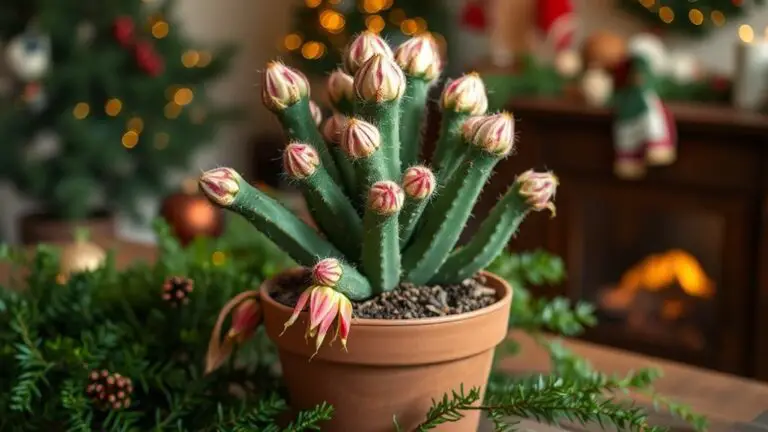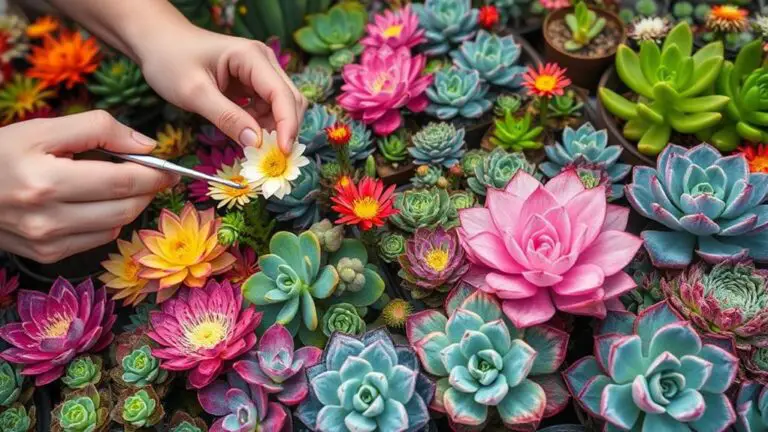10 Essential Steps to Cut Back and Root a Tall Cactus
Cutting back and rooting a tall cactus might seem intimidating, but with the right approach, it's entirely manageable. You'll need to gather vital materials like gloves, pruners, and a planter before anything else. Once you've assessed the cactus's health, planning and executing a precise cut becomes essential. But that's just the beginning—understanding how to properly handle the cuttings and apply rooting hormone can make all the difference in successful propagation. Are you ready to transform your towering cactus into thriving, new plants? Let's break down each step to guarantee you get it right.
Gather Your Materials
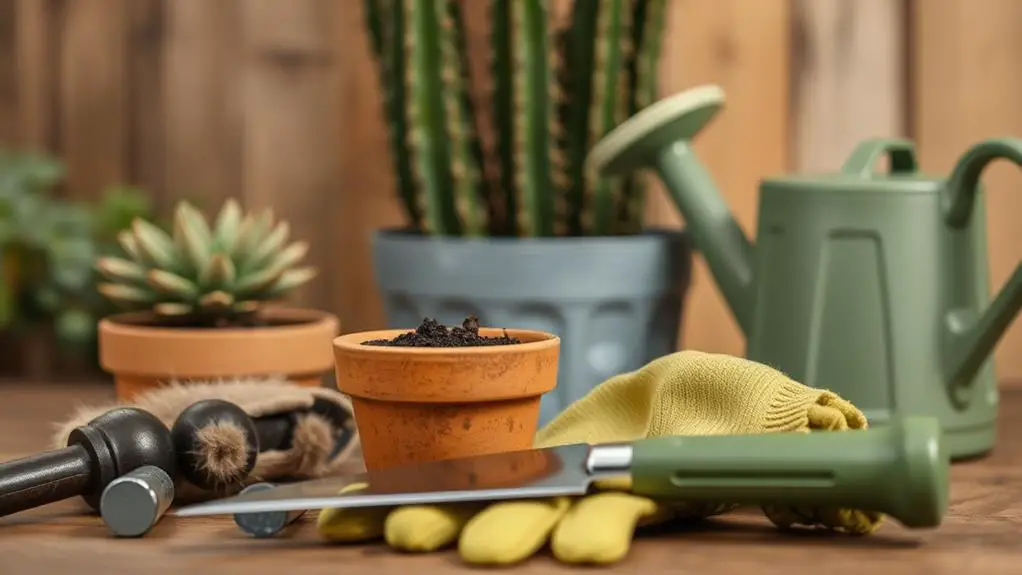
When you're planning to cut back and root a tall cactus, it's crucial to gather the right materials to guarantee the process goes smoothly.
Start by getting a pair of sturdy gauntlet gardening gloves to protect your hands from the cactus spines. Make sure you have sharp and clean pruners or a saw; dull tools can harm the cactus and cause disease.
You'll also need a terracotta planter that's the right size for stability and proper drainage. Use well-draining potting soil, ideally a mix of perlite and peat, to support healthy root growth after the cactus cutting.
For safety, have a plank of wood ready to guide the cactus down, and ask a friend to help.
Plan the Cut
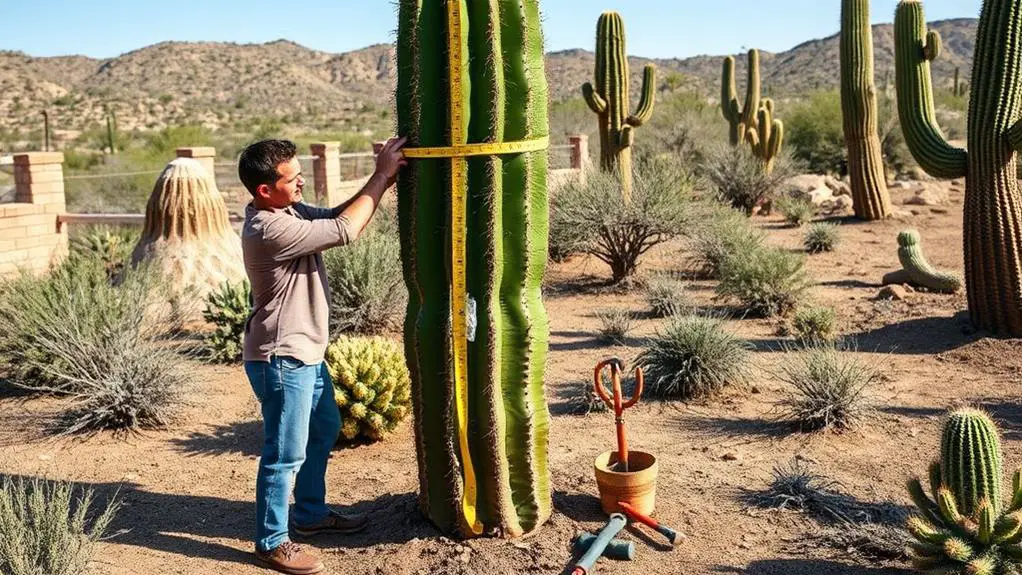
Before making any cuts, you need to assess the cactus's overall health and stability. Look for any signs of damage, disease, or overcrowding. Once you've determined the cactus is healthy enough, choose a notable notch or branch point for cutting. This helps encourage regrowth and reduces stress on the plant. Make certain you have sharp pruners or a saw, protective gauntlet gardening gloves, and long sleeves to prevent injury. Having a second person to assist and a plank of wood for support will make the process safer. Timing your cut during the warmer months can improve recovery and rooting success.
| Step | Action |
|---|---|
| Assess Health | Check for damage or disease |
| Choose Location | Pick a notch or branch point |
| Gather Tools | Pruners, gloves, long sleeves |
Plan the cut carefully to guarantee your cactus thrives.
Position the Cactus
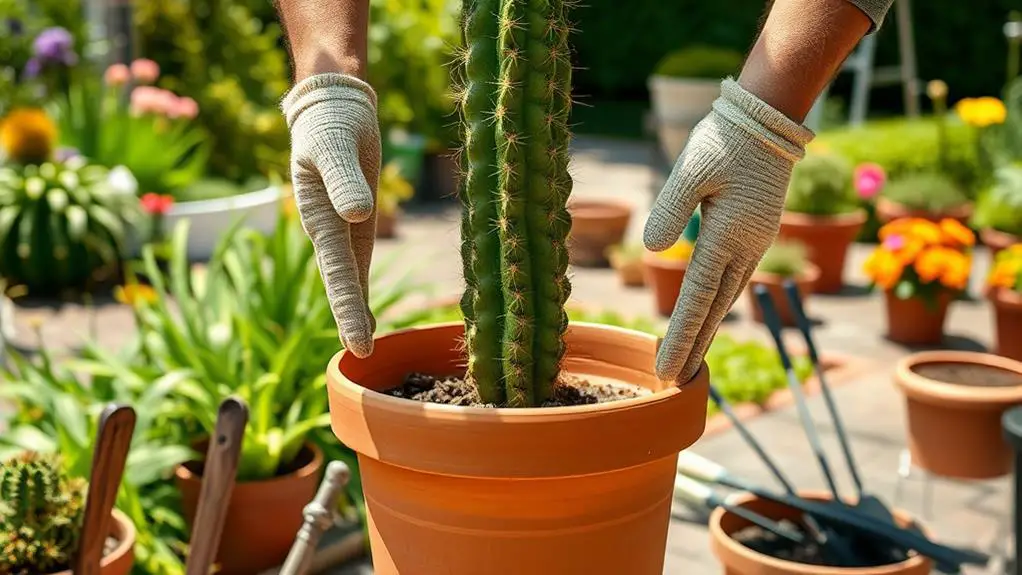
Positioning a 12-foot tall cactus for cutting requires careful planning and teamwork. First, clear the area of any obstacles to guarantee you have ample space to maneuver.
Put on your gauntlet gardening gloves and long sleeves to protect yourself from the cactus spines. With your partner, use a sturdy plank of wood to carefully guide the cactus down to ground level. Maintain a firm grip and communicate continuously to avoid any sudden movements.
Position the cactus in a well-ventilated area, which will help you access the necessary tools easily. This careful positioning guarantees a safe and efficient cutting process.
Make the First Cut
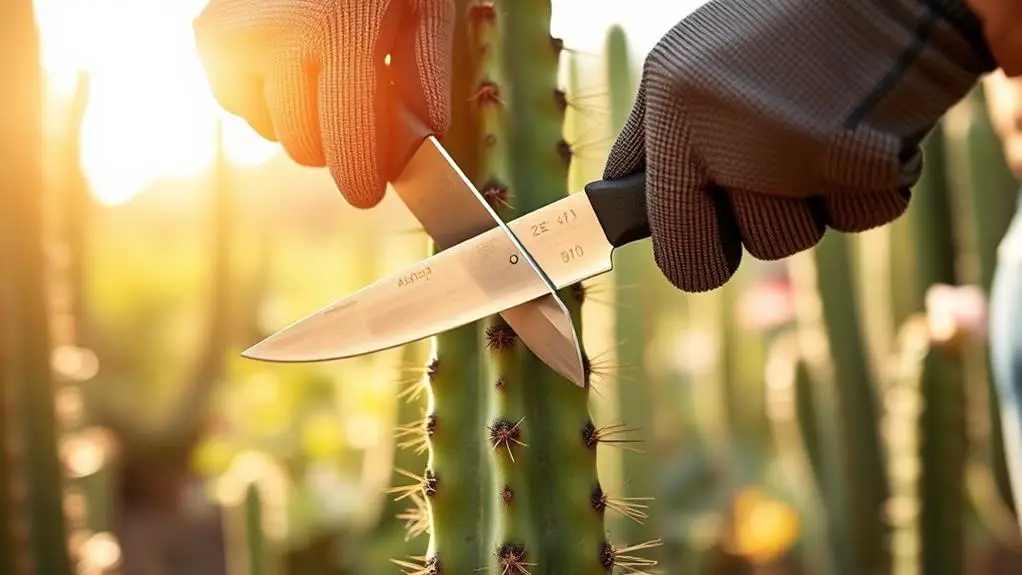
Before you make the first cut, gather your sturdy gardening gloves, sharp pruners, and a plank of wood for safety.
Make certain the cactus is stable by having a friend help guide it down gently.
Then, make a precise cut at a 45-degree angle at a notable growth point to encourage healthy regrowth.
Gather Necessary Tools
To safely cut back a tall cactus, gather essential tools like sharp pruners or a saw for larger cuts, sturdy gauntlet gardening gloves to protect against spines, and a plank of wood to guide the cactus to ground level.
Make sure your pruners are clean and sharp to guarantee a precise cut at a notable notch on the cactus. This helps minimize damage and promotes healthy regrowth.
Wear long sleeves and other protective gear to safeguard your arms and hands from the cactus spines.
Don't forget to have a buddy assist you in lifting and maneuvering the cactus.
Having the right tools and protective gear will make the process easier and safer for you.
Ensure Cactus Stability
Confirming the cactus is stable before making the first cut is essential for a successful pruning process.
First, use a plank of wood to support the cactus, guiding it safely to ground level with the help of another person. This confirms stability during the cut.
Identify a notable notch on the cactus where you'll make a clean cut with pruners at a 45-degree angle to minimize damage.
Wear gauntlet gardening gloves to protect your hands from the cactus spines.
After the initial cut, make sure the cactus remains upright and secure to prevent further stress.
Always check the cactus for signs of disease or instability before cutting, as these can impact its health and propagation success.
Make Precise Cut
When it's time to make the first cut, start by gearing up with gauntlet gardening gloves and long sleeves to shield yourself from the cactus spines. Select a notable notch on the cactus where you'll make your cut. Use sharp pruners or a saw to guarantee a clean cut, avoiding any crushing that can lead to infection. Aim for a 45-degree angle above the node. This helps minimize damage and encourages healthy regrowth. After cutting, moisten the cut end with water and let it callus for several days before you proceed with rooting.
| Step | Description |
|---|---|
| Gear Up | Wear gloves and long sleeves |
| Choose Spot | Select a notable notch for the cut |
| Make Cut | Use sharp tools, cut at a 45-degree angle above the node |
| After Care | Moisten cut end, allow to callus |
Handle the Cuttings
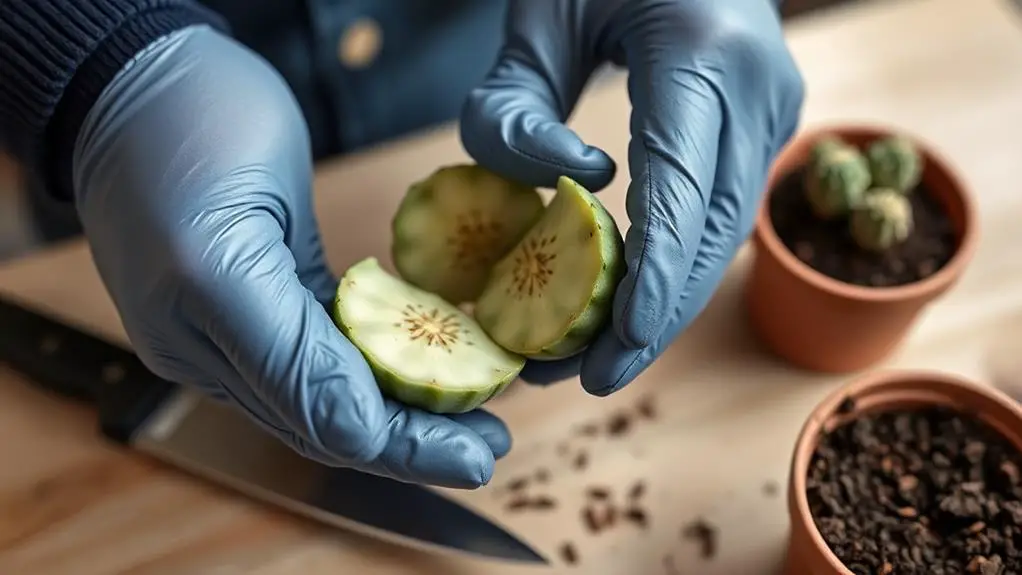
After pruning your tall cactus, allow the cut ends to dry and callus for 2-3 days in a warm, dry location. This step is essential to reduce the risk of rot when you cut back and root your cactus.
Inspect the cuttings to verify they're healthy and free from disease. Once calloused, plant the cuttings in a well-draining potting mix. Make certain at least one joint is buried to provide stability.
Don't water the cuttings immediately; wait until the soil is completely dry to prevent rot. Keep an eye on the cuttings for root development, providing bright indirect sunlight and minimal watering.
With careful handling, your cactus cuttings will thrive.
Prepare the Planter
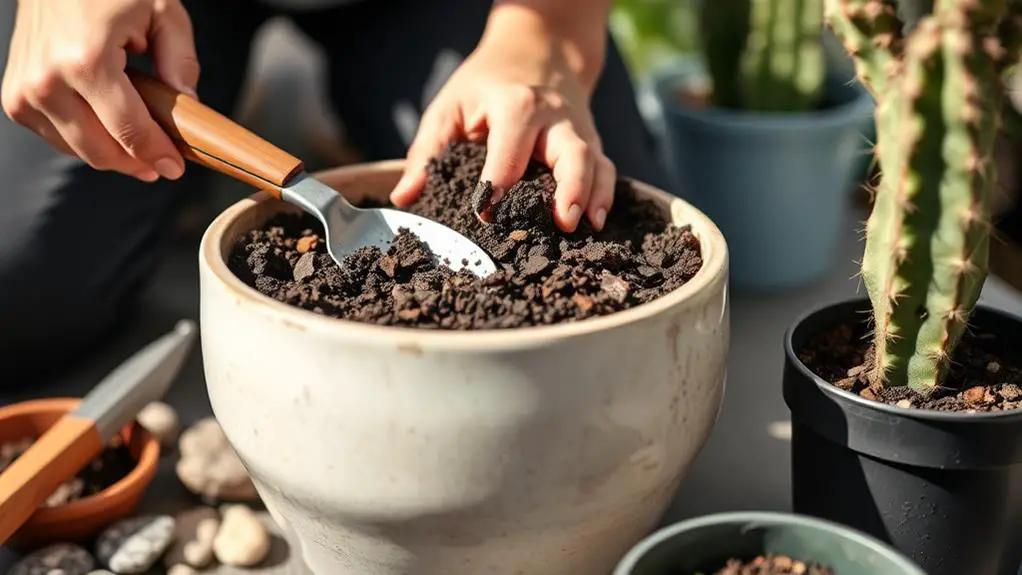
To get started, choose a terracotta planter that's just right for your cactus. It should be about 40cm high and 30cm wide if you have a larger cutting. Make sure it has drainage holes at the bottom. These holes are essential because they prevent water from accumulating, which can cause root rot.
Next, fill the planter with a well-draining potting mix. A good mix would be 75% perlite and 25% peat. This helps with aeration and keeps the soil from getting too soggy.
Lightly moisten the potting mix before placing your cactus cutting in it.
Rooting Hormone Application
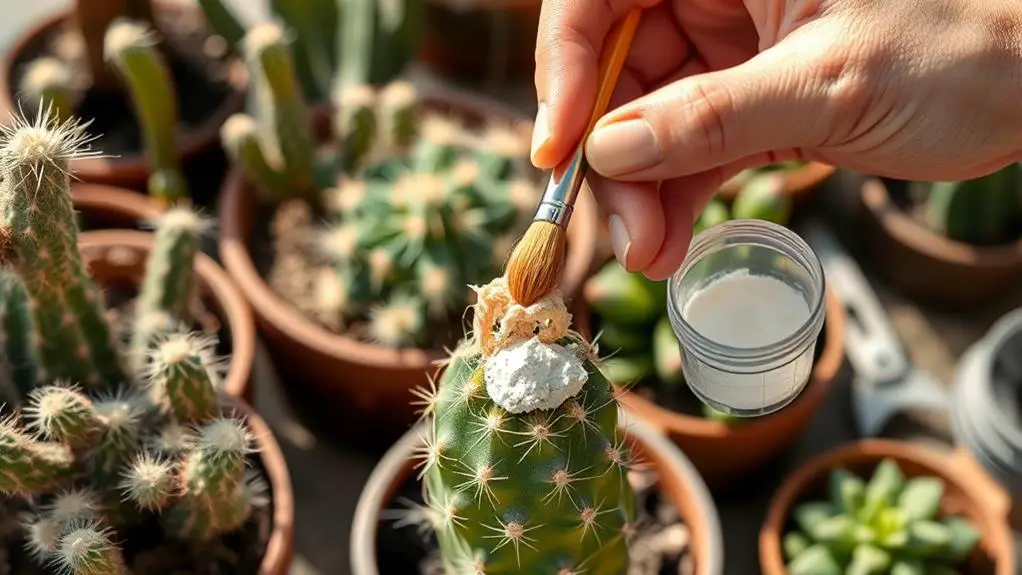
Applying rooting hormone is a crucial step in promoting faster root formation for your cactus cuttings.
Start by dipping the cut end into the rooting hormone powder, such as Rootex-P, containing Indole Butyric Acid (IBA). Gently tap off any excess to guarantee an even coating. This process is especially helpful during winter when propagation tends to slow down.
Next, place your cutting in a dry, well-ventilated area to let it dry. This helps the hormone work effectively.
Make sure your cuttings are healthy and disease-free before applying the hormone. This increases the chances of successful rooting and plant establishment.
Using rooting hormone can truly boost your cactus propagation success, making your efforts worthwhile.
Plant the Cutting
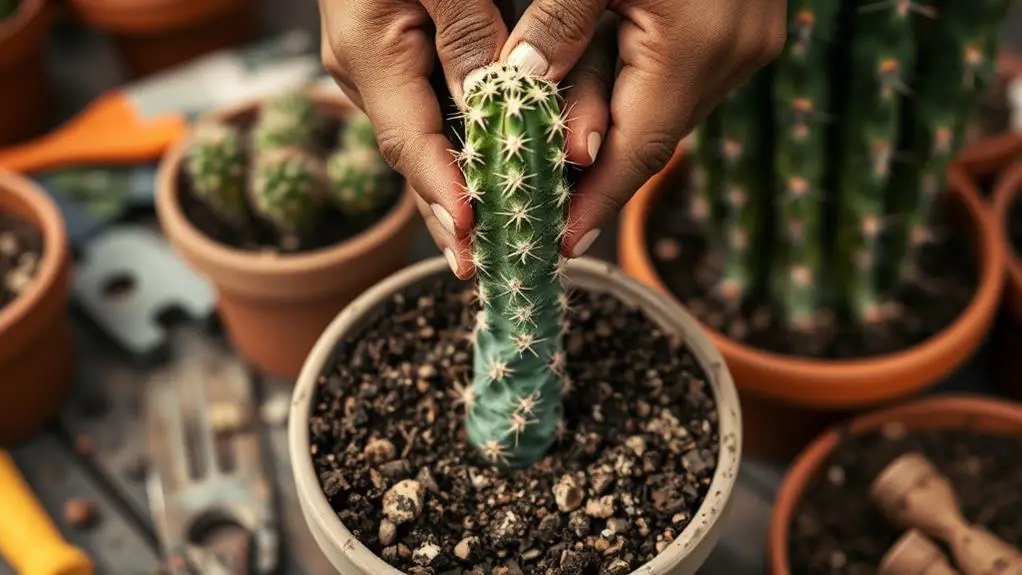
Ensuring your cactus cutting is ready for planting is crucial for its successful establishment. First, make sure the cut end has formed a callus by drying it in a warm, dry spot for several days.
Now, prepare a potting mix with 75% perlite and 25% peat potting mix for good aeration and moisture retention. Insert the callused end into the mix, burying at least one joint to keep it upright.
After planting, water lightly to settle the soil but avoid overwatering to prevent rot. Finally, place the pot in a bright area with indirect sunlight. This will encourage root growth without scorching the cutting.
Follow these steps, and your cactus will thrive!
Water and Care
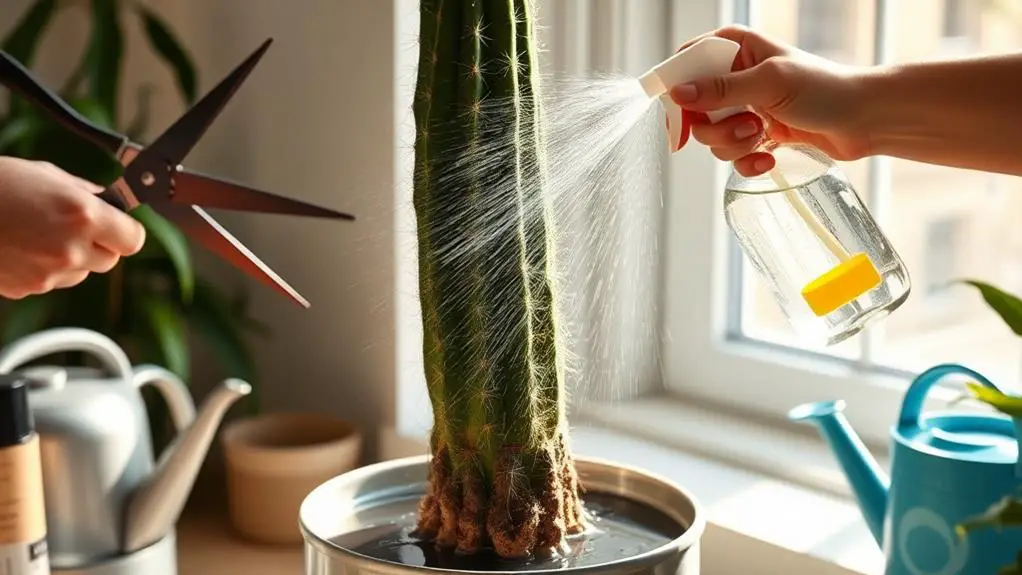
When it comes to watering your newly planted cactus, start by watering lightly to settle the soil, but be careful not to overdo it.
It's important to let the top inch of soil dry out between waterings to prevent root rot.
Mist the cactus every few days and use purified water to avoid chemical buildup, ensuring healthy root growth.
Proper Watering Techniques
To keep your tall cactus healthy and thriving, it's crucial to master proper watering techniques.
First, always verify the soil is completely dry before you water your cactus again. This usually takes about 2-3 weeks.
Use purified or distilled water to avoid harmful chemicals that can damage the cactus over time.
When you water, make sure you apply enough to see it drain from the bottom of the pot. This way, the roots get adequate moisture without becoming waterlogged.
- Use purified or distilled water: Tap water can contain chemicals that harm your cactus.
- Let the soil dry out: Prevent root rot by waiting until the soil is completely dry.
- Verify proper drainage: Water until it drains from the pot's bottom to keep the roots healthy.
Frequency of Watering
Maintaining a healthy cactus involves more than just proper watering techniques; understanding the frequency of watering is equally important. During the growing season, water your cactus every 1-2 weeks. In winter, reduce this to every 3-4 weeks. Always allow the soil to completely dry out between waterings. Check if the top 1-2 inches of soil feel dry before adding water.
After planting, water lightly to settle the soil but be careful not to overwater. Use purified or distilled water, and make certain water seeps from the drainage holes.
Monitor conditions like light and ventilation, which affect how quickly the soil dries. Following these steps will help your cactus thrive without risking root rot.
Ideal Soil Conditions
Selecting the right soil mix is essential for the health of your cactus. For ideal soil conditions, use a well-draining soil mix composed of 75% perlite and 25% peat potting mix. This combination provides excellent aeration and moisture retention, vital for cactus cuttings.
When watering, wait until the soil is completely dry, then water thoroughly until it seeps from the drainage holes. Mist the soil lightly every 3-5 days to encourage root growth during the initial rooting phase.
Remember to:
- Use purified or distilled water to avoid chemical buildup.
- Place your cactus in bright, indirect sunlight to prevent sunburn.
- Monitor soil dryness to prevent root rot.
Monitor Growth
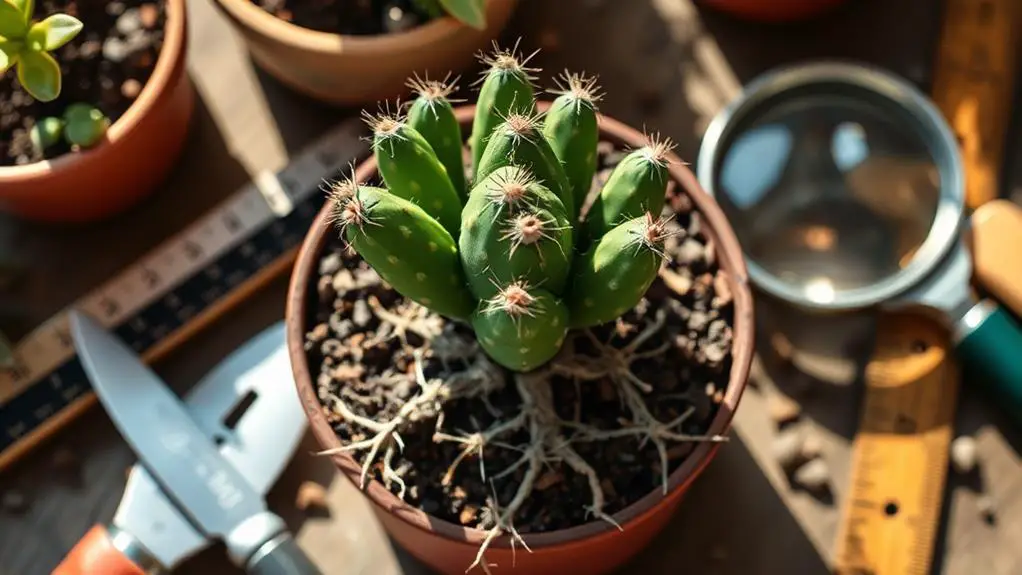
Regularly monitoring your cactus's growth is essential for maintaining its health and stability. You should check for signs of overgrowth like leaning or overcrowding, as these indicate it's time to prune a cactus to promote healthy development.
Look for discoloration or soft spots, which could signal infections or rot needing immediate attention. Keep an eye on its growth patterns and stability; if your cactus becomes top-heavy or unstable, corrective pruning might be necessary.
Also, track how your cactus responds to changes in water, light, and soil. Adjust care as needed to keep it thriving.
Recording new growth and changes after pruning helps you gauge the success of your efforts, ensuring your cactus stays robust and vibrant.
Frequently Asked Questions
How to Cut a Cactus That Is Too Tall?
To cut a tall cactus, use sharp, clean pruners or a saw at a 45-degree angle. Wear protective gloves and sleeves. Have someone assist you for safety. Let the cut end dry before replanting.
How to Root a Large Cactus Cutting?
You'll need to let the cactus cutting callus for a few days, then moisten and dip it in rooting hormone. Plant it in well-draining soil, place it in indirect light, and water sparingly when dry.
Can You Put Cactus Cuttings Straight Into Soil?
You shouldn't put cactus cuttings straight into soil. Let the cut end dry and form a callus in a well-ventilated area for 2-3 days first. This prevents rot and promotes healthy rooting when you plant it.
Can You Cut off a Piece of Cactus and Regrow It?
Yes, you can cut off a piece of cactus and regrow it. Let the cut end callus for a few days, dip in rooting hormone, then plant it in well-draining soil. Water lightly and provide indirect light.
Conclusion
You've got this! By following these steps, you'll successfully cut back and root your tall cactus. Remember, patience is key. Keep an eye on moisture levels and give your cactus plenty of indirect sunlight. With careful attention, your new cactus cutting will thrive and grow strong. Gardening can be a rewarding experience, so enjoy each moment and learn as you go. Happy planting, and don't hesitate to ask for help if you need it!

